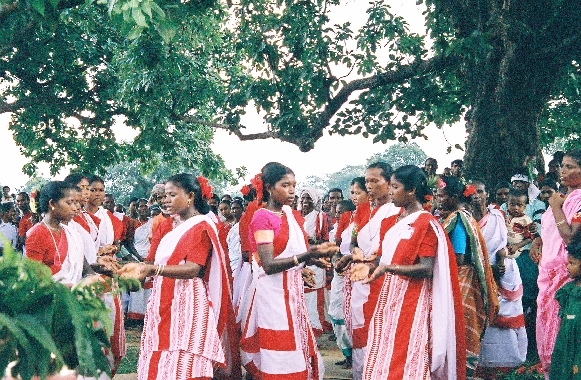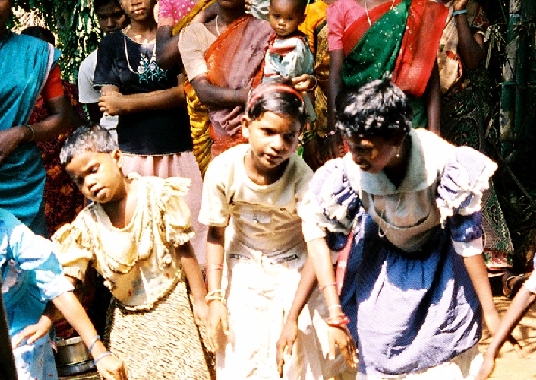|
We had about a 3 hour train ride, and then a 2 hour drive to get to Dumka. The jeep wasn't air-conditioned, and the seats
weren't particularly well-padded either, and the sensations I recall most clearly from that section of the trip involve feeling
hot, dusty, and bruised. But it was a wonderful trip.
Dumka is in a less populous region of India, and the people are tribal, primarily from the Santal tribe. They are not
native to the region -- they were brought by the British to clear the land for agriculture. They are not Hindu, and are outside
the caste system. They are among the poorest, most marginalized and most exploited people in India. We stayed at the Social
Development Center in Dumka, which is run by the Catholic Church. A priest there, Father Christu, has devoted most of his
life to working with the Santal on numerous fronts, including preserving their culture.

The Santal culture is rich in hospitality. We were introduced to it the afternoon that we first arrived in Dumka, as we drove
slowly up a narrow dirt track behind a huge crowd of people, only to meet an even larger crowd waiting for us, headed by a
group of men who led us on, drumming and dancing. We were going to a meeting place shared by three villages, and the men
had a long, uphill route, but somehow they maintained their tempo. We were met near the end by a group of women who danced
and sang as we approached a pavilion that had been rigged out of bamboo and saris. We were given bouquets and the women washed
our feet. The generosity of the welcome was overwhelming.

|
| "...and she will swim like a fish" |
We had two more site visits while we were in Dumka, and both times we were welcomed with songs and dances. The first visit
was to a village, where we got to see the cultural preservation and literacy programs in action, as the women read the words
to the song they were singing from a notebook, and the men coached each other through the not-yet-familiar choreography of
a traditional dance. The little girls in this village were one of the highlights of the visit -- they participated in the
greeting song and dance right along with the older girls and women, and then they performed their own song and dance, saying
that "more precious than a parent's love is wisdom. Teach a child, and she will fly like a bird and swim like a fish."
They were adorable -- shy, but lively, and quite proud of themselves. When we asked why the village boys hadn't given a
performance, it was explained to us that there was a soccer game going on, and for the boys, nothing is more important than
soccer.
The second place we visited was a school run by the Catholic Church. The church on the school grounds was converted to
an auditorium for our visit, and it was packed with children and their parents. The children put on a pageant for us, with
traditional and modern songs and dances. Afterward, we had tea and cake at the convent with the sisters who run the school.
We left late, walking out into the intense darkness of the night with a sea of stars overhead, and the voices of the children
singing their evening prayers.
I've really only just scratched the surface of my experience in India. I could go on forever if I tried to catalog everything
I saw or felt. It was like no other place I've ever visited, and the experience was incredibly rich. Not always enjoyable,
maybe, but very valuable. India is complex and contradictory and gorgeous, and I'm grateful that I had the opportunity to
experience it a little bit of it for myself.
|